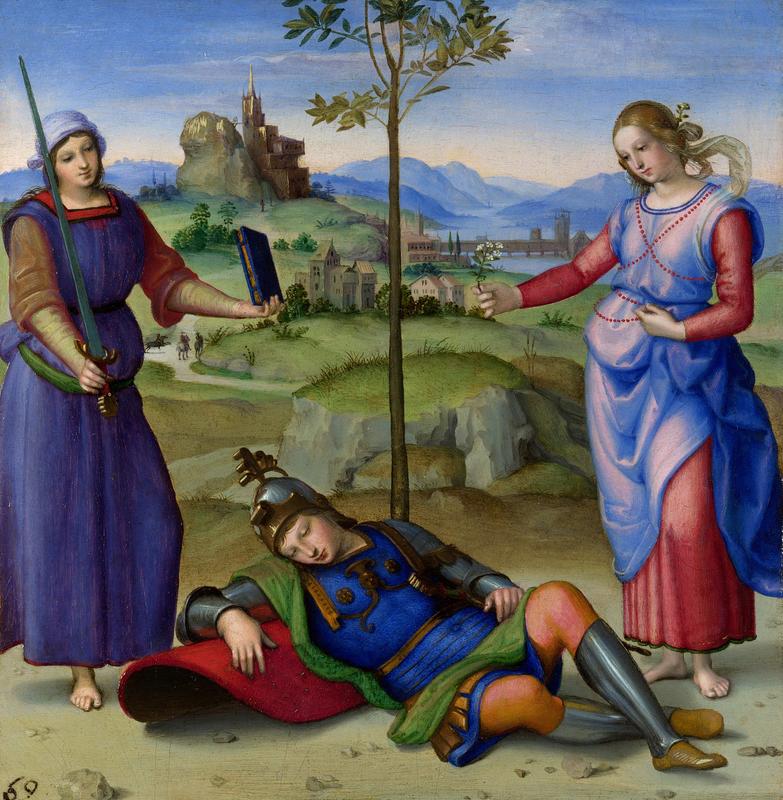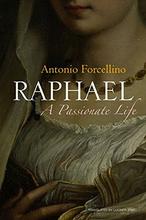More about The Dream of a Knight
- All
- Info
- Shop

Contributor
An Allegory (‘Vision of a Knight’) by Raphael is a little like when, in cartoons, a devil and an angel sit on a character’s shoulders and advise the character on what to do in a given situation, except this time they sort of compromise.
This knight is believed to be Scipio Africanus, a Roman general who was thought to be one of the best military minds in history. He is shown here sleeping on the job. But while sleeping he has a dream of two women. Now before you get ahead of yourself here, I’ll tell you that these women are Virtue and Pleasure, who are enemies of one another, and they are about to have a lengthy discussion about whether or not Scipio should go to battle.
He’s young and a little naive, but his father and uncle before him were both great leaders who lost their lives in battle and it seems that Scipio should do the same. Pleasure is pictured on the right with her hair ribbon blowing in the wind, in a purple and red robe, gazing sweetly upon Scipio. She is in favor of Scipio staying home and enjoying his adolescence without the horrors of war. She says that if he stays home he’ll never have to experience things like “the northern cold” or “the fierce heat of Cancer” or “the pangs of thirst.” He’ll live a long and happy life of chillin’.
Then Virtue, who is dressed more practically than Pleasure, has the left stage and thinks that Pleasure is stupid for encouraging a young, hot guy like Scipio to just sit home and waste away his youth. If he were to do that he would die in obscurity, which is really uncool. She talks of the pride and the fortune that he would have if he were to go to battle and win. She says that he’ll suffer, but in the end it’ll be worth it for the glory. And because this option is a lot sexier than what Pleasure had to offer him, he decides to go to battle. Pleasure is really bitter about it though and says something along the lines of "Screw you guys, I hate high school."
Despite what it seems like, this piece is not actually meant to be a battle between Pleasure and Virtue. It’s supposed to be a reminder that a good and wholesome soldier considers both aspects equally. Virtue is holding a book and a sword, while Pleasure holds a flower; these are symbols of knowledge, bravery and peace that, when combined, should make a well-rounded knight.
Sources
- "Passage In The Punica | Studying Raphael | Research | The National Gallery, London." Nationalgallery.org.uk. N.p., 2018. Web. 18 Oct. 2018. https://www.nationalgallery.org.uk/research/passage-in-the-punica
- "Raphael | An Allegory ('Vision Of A Knight') | NG213 | National Gallery, London." Nationalgallery.org.uk. Web. 18 Oct. 2018. https://www.nationalgallery.org.uk/paintings/raphael-an-allegory-vision…
- "Scipio Africanus." Biography. N.p., 2014. Web. 18 Oct. 2018. https://www.biography.com/people/scipio-africanus-21468171#final-years-…
Featured Content
Here is what Wikipedia says about Vision of a Knight (Raphael)
The Vision of a Knight, also called The Dream of Scipio or Allegory, is a small egg tempera painting on poplar by the Italian Renaissance artist Raphael, finished in 1503–1504. It is in the National Gallery in London. It probably formed a pair with the Three Graces panel, also 17 cm square, now in the Château de Chantilly museum.
There are a number of theories as to what the panel is intended to represent. Some art historians think the sleeping knight represents the Roman general Scipio Aemilianus (185–129 BC) who, according to Cicero's Somnium Scipionis, dreamed that he had to choose between Virtue (behind whom is a steep and rocky path) and Pleasure (in looser robes).
"This sleepy Lancelot also conjures up memories of another ancient hero: the Roman general Publius Cornelius Scipio Africanus Aemilianus, who toured the cosmos in a dream and learned (at least according to Cicero) that the reward of virtue is a place among the stars in heaven."
However, the two feminine figures are not presented as contestants. They may represent the ideal attributes of the knight: the book, sword, and flower that they hold suggest the ideals of scholar, soldier and lover which a knight should combine.
The most likely source for the allegory depicted is from a passage in the Punica, an epic poem recounting the Second Punic War by the Latin poet Silius Italicus.
The panel was moved to England by William Young Ottley in 1800.
Raphael used an extensive palette of paints to depict this colourful scene. Pigments such as lead-tin yellow, ultramarine, verdigris and ochres have been identified in an pigment analysis at ColourLex.
Check out the full Wikipedia article about Vision of a Knight (Raphael)













